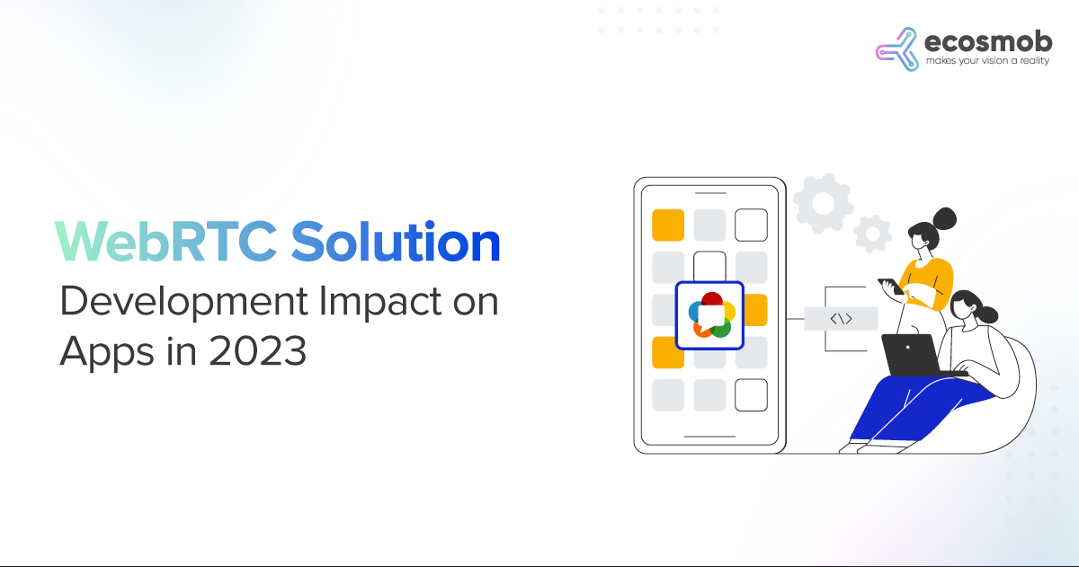
With new technologies appearing frequently, the digital world is continuously in flux. Few technologies significantly impact the constantly changing field of app development, such as WebRTC. WebRTC, or Web Real-Time Communication, is an open-source technology that has completely changed how real-time data sharing and communication between applications work. WebRTC Solution Development’s influence on apps has been revolutionary because of its capacity to redefine possibilities.
You might have thought that the struggle for market dominance of Internet browsers was a decade ago, but that’s not true. The browser war is back with the rising popularity of Web Real-Time Communications, or WebRTC, as an HTML5 value-added function. The good news is that as browser vendors support Mozilla Firefox and Google Chrome in their efforts to enable WebRTC in their products, an increasing economy of scale will push the developers to meet the demand sparked by increased creative use cases.
Web 2.0: The Evolution of the Internet and the Rise of User-Generated Content
Around 2004, the idea of Web 2.0 served as the impetus for the most recent browser conflict. The first Web 2.0 conference, organized by O'Reilly Media and MediaLive, introduced the term and defined it as— The Web as a Platform where software applications are produced on the Web rather than the desktop with the help of new interactive browser features. The distinctive part of this migration was the addition of user-generated content, which is used to boost value and application functioning. User-generated content can take the shape of thoughts, words, videos, or photographs. Unquestionably, Web 2.0 sparked a web developer boom that gave rise to many of the top web services we use today and brought immeasurable value to national and international economies.
Introducing WebRTC to Redefine Web 3.0
Web 3.0 is called "a next generation of Internet-based services that collectively comprise what may be called "the intelligent Web," such as those using microformats, semantic Web, natural language search, machine learning, data mining, recommendation agents, and artificial intelligence technologies," which emphasize machine-facilitated comprehension of information, based on a unique report by Lifeboat Research. A more precise definition of Web 3.0 is when web app developers begin to embrace real-time multimedia conversations by utilizing WebRTC.
Is the WebRTC feature in HTML5 a substantial enough advancement for app and website developers to support the designation and redefining of Web 3.0? Indeed, the hype cycle on the side of the communications developers could support such an assertion. Will the greater community of web and mobile app developers feel the same, though? The answer depends on how rapidly HTML5 developers adopt WebRTC.
WebRTC's Transformative Effects on App Development
Application development has undergone radical changes due to WebRTC, especially in real-time communications. It enables peer-to-peer communication directly in web browsers, mobile platforms, and IoT devices without using extra plugins or third-party software. Let's look at some of the revolutionary impacts WebRTC solutions on the app’s creation:
Enhanced User Experience
A simple and seamless user experience is now possible, thanks to WebRTC. Users can directly converse in real time without downloading additional plugins or programs. Everything, including video calls, audio chats, and data sharing, occurs entirely within the application. Time is saved, and the user experience is more streamlined and exciting.
Cost-Efficiency
The costs involved with implementing real-time communication capabilities have significantly decreased with the introduction of WebRTC development. Developers are no longer required to spend money on specialized servers or third-party solutions. Instead, they can reduce infrastructure costs by utilizing WebRTC's peer-to-peer features.
Scalability and Interoperability
Cross-platform compatibility is emphasized in the development of WebRTC solutions. It implies that WebRTC-based applications can function on various hardware and browsers, assuring a large user base. Additionally, because of its architecture's intrinsic scalability, developers may scale their applications more easily as user needs increase.
Increased Innovation
WebRTC has made it possible to innovate. Thanks to real-time connectivity. Developers can now test out new use cases and functionalities. The possibilities are endless, ranging from healthcare programs to online learning environments.
Improved Security
Enhancing Security is one of the main issues with real-time communication. WebRTC incorporates end-to-end encryption to alleviate this issue and ensures that data sent between parties is secure and private.
Adaptability and Customization
Developers can take advantage of the numerous APIs and tools that WebRTC provides. It enables a great deal of customization. Developers can create solutions suited to particular needs, whether a straightforward voice chat feature or a sophisticated multi-user video-conferencing application.
The Future: Beyond Traditional App Development
WebRTC has an impact that goes beyond traditional app development. The need for real-time communication is growing along with augmented reality (AR), the Internet of Things (IoT), and virtual reality (VR). The design of WebRTC is well-suited to support these cutting-edge technologies.
Consider a situation where an expert stationed far away could provide real-time assistance to a technician wearing AR glasses or think about the opportunities in a VR game setting where players can interact in real-time, enhancing their gaming experience. These are merely hints at what lies ahead, with WebRTC at the fore.
Wrapping Up!
A new era in app development has begun with the introduction of WebRTC Development. WebRTC has allowed developers to innovate and rethink the boundaries of what is possible by removing the obstacles that previously prevented real-time communication from being embedded in apps. WebRTC's importance will only increase as technologies advance and the digital environment changes, solidifying its status as a game-changer in app development.
Share this post
Leave a comment
All comments are moderated. Spammy and bot submitted comments are deleted. Please submit the comments that are helpful to others, and we'll approve your comments. A comment that includes outbound link will only be approved if the content is relevant to the topic, and has some value to our readers.

Comments (0)
No comment